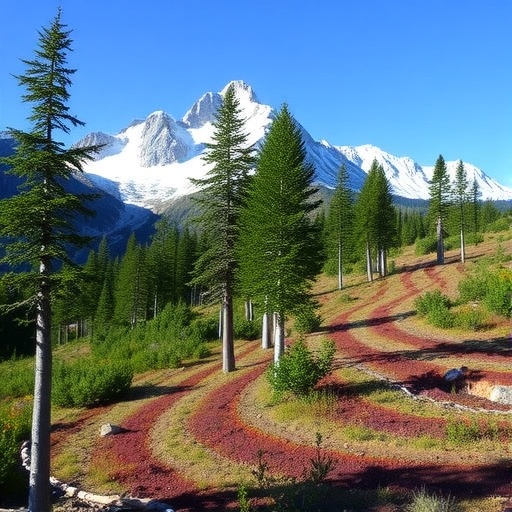Alpine ecosystems, characterized by their breathtaking landscapes and unique biodiversity, find themselves at the forefront of ecological research, especially regarding climate change. As global temperatures rise, alpine treelines and shrublines are witnessing profound shifts. These ecological boundaries act as indicators of climatic conditions, responding to a delicate balance of environmental influences including temperature, water availability, and species interactions. A recent comprehensive review underscores the complex dynamics of these alpine ecotones and their response to climate change, highlighting key findings that illuminate the urgency of understanding these critical ecosystems.
The review reveals that continental alpine treeline and shrubline elevations manifest significant geographical patterns, with the highest altitudes found in mid-latitude regions. As one moves toward lower latitudes and polar regions, these elevations decrease. Such a pattern underscores the intricate relationship between climate variables and terrestrial life forms that have adapted over millennia. Notably, shrublines exist approximately 335 meters higher than the associated treelines, suggesting that shrubs can thrive in slightly harsher conditions than trees. This elevation difference is attributed to the unique morphological characteristics of various species, whereby the adaptability of shrubs allows them to extend their range as climatic conditions change.
A pivotal factor influencing the distribution of these treelines and shrublines is the mass-elevation effect. Larger mountain ranges retain more heat, thereby creating a microclimate conducive to plant growth at higher altitudes. This phenomenon highlights the intricate interplay between topography and climate in determining ecological boundaries. Temperature remains a critical determinant in the establishment of these alpine ecosystems. Research indicates that tree growth at alpine treelines initiates around 0.9 °C and continues to flourish as the average temperature during the growing season surpasses 6.4 °C for at least 94 days. This temperature threshold is crucial, as it delineates suitable growing conditions from inhospitable ones.
Water availability further complicates this picture, as drought stress significantly impacts 51% of alpine treelines. The combination of temperature and moisture availability creates a complex web of interactions that dictate plant viability in these challenging environments. As climate patterns shift and the frequency of droughts increases, the health of these high-altitude ecosystems hangs in the balance, showcasing yet another layer of the urgency tied to climate resilience.
The review also highlights alarming trends in the movement of alpine treelines and shrublines. Between 1901 and 2021, there has been a pronounced upward shift in these boundaries, with alpine treelines moving approximately 0.40 meters per year and shrublines advancing even faster at 0.49 meters per year. This trend is more pronounced at higher latitudes, where warming is occurring at an accelerated rate. Such shifts signal a drastic reorganization of alpine ecosystems, affecting not only the plants at the upper limits of their range but also the myriad species that rely on these critical habitats.
One intriguing facet of this upward shift is the lag effect observed in treeline movement. It appears that alpine treelines are significantly delayed in their response to climate warming, with projections indicating a lag of at least 50 years. This time lag could lead to ecological mismatches, where the conditions for species survival fail to align with the environmental changes occurring at a rapid pace. Drought stress, coupled with competition from other species and disturbances such as wildfires or landslides, amplifies this complexity, further challenging the resilience of alpine ecosystems.
While the direct effects of climate change on vegetation shifts are understood, the implications for ecosystem services are less clear. The advancement of treelines and shrublines is poised to disrupt soil carbon storage essential for climate regulation. As trees and shrubs encroach upon previously uninhabited areas, the dynamics of soil composition will undeniably change, potentially leading to diminished carbon stocks. This scenario emphasizes the importance of understanding how vegetation shifts may influence greenhouse gas emissions and—ultimately—the global climate system.
Biodiversity, another crucial component of alpine ecosystems, is also under threat. The complexity of species interactions, such as facilitation and competition, serves as a double-edged sword. On one hand, certain species may thrive as they capitalize on newly available niches; on the other hand, plants that are less adaptable may suffer, leading to a decline in overall biodiversity. This balancing act of species interactions paints a complicated picture of how these shifts will play out in the coming decades.
Moreover, as treeline and shrubline advances alter surface albedo—the reflection of solar radiation—the cascading effects on the climate system could be profound. A decrease in surface albedo typically leads to increased heat absorption, creating a feedback loop that perpetuates further warming. This phenomenon underscores the interconnectedness of alpine ecosystems with broader climate systems, requiring a holistic approach to understanding climate impacts.
Future research must prioritize field monitoring to enhance our understanding of alpine ecosystems’ responses to climate change. Such data will be instrumental in improving projections of treeline and shrubline dynamics, helping inform conservation strategies and policy interventions. As these ecosystems continue to change, understanding the underlying mechanisms will be critical to mitigating potential negative consequences.
In conclusion, alpine treelines and shrublines present a striking narrative of nature’s response to climate change—a narrative that illustrates both resilience and vulnerability. As temperatures rise and ecosystems shift, these boundaries will serve as vital indicators of broader environmental changes. Further investigation into their dynamics will not only deepen our understanding of alpine biodiversity but also inform strategies for preserving these vital ecosystems in the face of ongoing climate challenges.
Subject of Research: Alpine treelines and shrublines
Article Title: Patterns, dynamics and drivers of alpine treelines and shrublines.
Article References: Lu, X., Zheng, X., Liang, E. et al. Patterns, dynamics and drivers of alpine treelines and shrublines. Nat Rev Earth Environ 6, 489–502 (2025). https://doi.org/10.1038/s43017-025-00703-9
Image Credits: AI Generated
DOI:
Keywords: Alpine treelines, shrublines, climate change, ecological boundaries, biodiversity, soil carbon storage, temperature, water availability, species interactions, environmental change.




